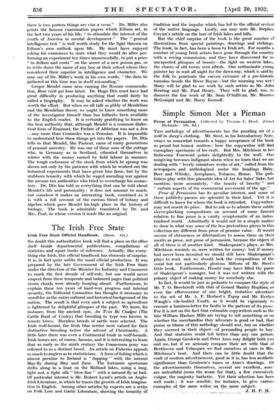The Irish Free State
Irish Free State Official Handbook. (Bean. lb's.)
No doubt this authoritative book will find a place on the office shelf beside departmental publications, compilations of statistics and squat books of reference. Actually, like every- thing else Irish, this official handbook has elements of surprise. It is, in fact quite unlike the usual official production. It was prepared by the late Government of the Irish Free State under the direction of the Minister for Industry and Commerce to mark the first decade of self-rule, but one would never suspect from these temperate and balanced pages that political storm clouds were already looming ahead. 'Furthermore, to explain these ten years of hard-won progress and internal security, the Editorial Committee has thought it necessary to unroll for us the entire cultural and historical background of the nation. The result is that even such a subject as agriculture is lightened by delightful glimpses of the past. We learn, for instance, from the ancient epic, An Tan Rd Cualgne (The Cattle Raid of Cooley) that breeding to type was known in remote times. Hornless breeds of cattle were selected. The Irish wolf-hound, the Irish blue terrier were valued for their distinctive breeding before the advent of Christianity. A little later there was even a Continental trade in wolf-hounds. Irish horses are, of course, famous, and it is interesting to learn that as early as the ninth century the Connemara pony was referred to as a distinct breed. An article on Fisheries appeals as much to anglers as to statisticians. A form of fishing which is almost peculiar to Ireland is " dapping " with the natural May-fly during May and June. The fortunate sportsman drifts along in a boat on the Midland lakes, using a long, light rod, a light silk " blow-line " with a natural fly as bait. Of particular interest is Mr. Robert Lynd's article on Anglo- Irish Literature, in which he traces the growth of Irish imagina- tion in English. Among other articles by experts are a seriis on Folk Lore and Gaelic 'Literature, shoWing the tenacify_ of tradition and the impulse which has led to the official revival of the native language. Lastly, one may note Mr. Stephen Gwynn's article on the lure- of Irish lakes and hills.
But the chief surprise of the book is the great 'number of illustrations from special paintings, drawings and etchings. The book, in fact, has been a boon to Irish art. For months a number of young Irish artists have gone through the country with a roving commiasion, and they have discovered for us unexpected glimpses of beauty—the light on western lakes, the charm of old towns seen afresh. One enthusiastic young painter lay in wait all night for the dawn-ray, which is said by the folk to penetrate the careen entrance of a pre-historic tumulus beside the River Boyne—but the morning was wet? Many will be glad to see work by such artists as Mr. John Keating and Mr. Paul Henry. They will be glad, too, to discover the fine work of Mr. Sean O'Sullivan, Mr. Maurice MeGonigal and Mr. 'Harry Kernoff.






































 Previous page
Previous page